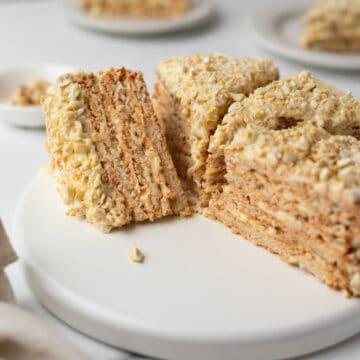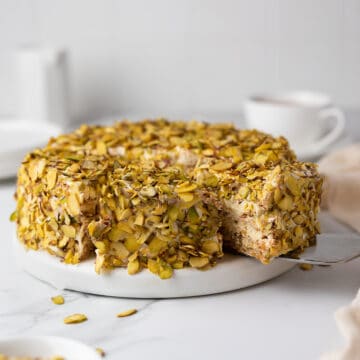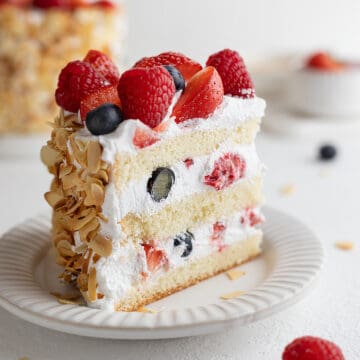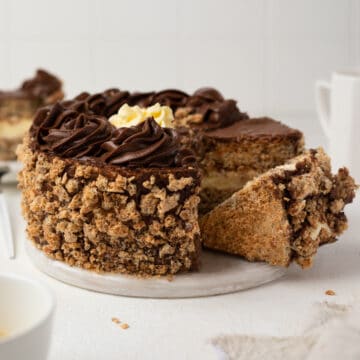Oil sponge cake is a butter-free, light, and moist sponge, perfect for those with food allergies and sensitivities. With the flavorful olive oil, it is full of delicious flavor, texture, and taste. What's more? It is easy to make with only 5 ingredients!

This oil sponge cake or no butter sponge cake is a new and exciting way to serve your guests. It is spongy, light, and airy inside, with a beautiful flavor of olive oil. It doesn't overwhelm the taste buds but still leaves them willing more.
Jump to:
Olive oil isn't restricted only to salads. With its distinct flavor and amazing taste, it is used to make cakes, muffins, and other baked goodies.
And if you prefer not to have any butter, cream, or yogurt in your diet, discover the secret to baking a deliciously moist cake using oil instead of butter.
But if you are looking for simple oil- and butter-free sponge cake, try my favorite - Italian sponge cake.
Oil sponge cake recipe
- This light, fluffy cake is one of those oil cakes with no baking powder, so it relies on the eggs for rising.
- Olive oil creates a truly sensational cake with a soft and moist texture and unforgettable flavor.
- This easy oil sponge cake recipe is a basic recipe; for example, it is ideal if you want to make a layered cake.
Ingredients

For ingredients and detailed instructions, refer to the recipe card below.
- Eggs: The recipe calls for large eggs. Ensure they are at room temperature before you start: bring them to the countertop an hour before. You will need to whip the eggs with sugar over a bain-marie/water bath to prepare the mixture to incorporate the air bubbles during whisking.
Pro tip: Alternatively, you can use a trick I always use: place whole eggs in a bowl of warm water for a few minutes.
- Sugar: Use granulated sugar or caster sugar to make the recipe.
- Olive oil fixes the aromas, brings moisture and softness to the cake, and prolongs its shelf life. You can replace extra virgin olive oil with sunflower oil, vegetable oil, rapeseed oil, etc.
Pro tip: If you want to learn more about how to make a cake moist, please, read my guide.
- Milk: The recipe calls for whole milk at room temperature.
- Flour: Use all-purpose flour (aka plain flour).

How to make olive oil sponge cake
Step 1. With cooking spray, grease an 8-inch (20 cm) round cake pan, then place a parchment paper circle at the bottom of the pan.
Step 2. Using a flour sifter, sift all-purpose flour in a large mixing bowl and set aside.
Step 3. Preheat the oven to 350°F (175°C). Place eggs and sugar in the bowl of a stand mixer and lightly beat with a hand whisk.
Step 4. Place the bowl over the bain-marie/water bath and heat the mixture to 104°F (40°C) or warm to the touch, constantly whisking.
Step 5. Remove the bowl from the water bath. Fit your stand mixer with a whisk attachment.
Step 6. Beat the egg mixture for 5 minutes at high speed and 10 to 15 minutes at medium speed until the ribbon stage (photo 1).
Step 7. Sift one-third of the flour over the surface of the mixture. Mix with a rubber spatula, going from the center to the edge, with gentle folding motions.
Pro tip: Fold in the flour slowly and carefully. Also, rotate the bowl with the other hand while mixing the batter.
Step 8. Whisk the oil and milk with a fork. Pour ⅓ of the mixture into the batter and gently mix (photo 2). Alternate dry and liquid ingredients until the batter is creamy and homogeneous.

PHOTO 1

PHOTO 2
Step 9. Pour the batter into the prepared tin (photo 3).
Step 10. Bake for 30 to 35 minutes (photo 4).
Pro tip: Check the doneness of the cake with a cake tester or a toothpick. If it is inserted in the center of the cake and comes out clean or with a few crumbs, the cake is ready.

PHOTO 3

PHOTO 4
Step 11. Remove the cake from the oven and let it cool in the mold for 5 to 10 minutes. It should shrink slightly around the edges of the mold.
Step 12. Unmold the cake by turning the baking pan upside down. Next, remove the parchment paper and invert it again, placing it on a serving platter.
To serve, dust the cake with icing sugar.

Expert Tips
- Don't skip or decrease the time necessary to whip the egg and sugar mixture. To maintain the fluffy texture of the cake, it is essential to beat plenty of air into the mix.
- Add dry and wet ingredients to the preparation slowly and gently.
- Bring the cake batter to the preheated oven once poured into the cake pan.
- Don't open the oven door during the first 30 minutes of baking.
- Unmold the cake from the pan for 5 to 10 minutes after taking it out of the oven to prevent it from falling apart.
- Let it cool completely on a wire rack so the cake cools more evenly, keeping its texture light and airy.
Recipe variations
It is a basic cake recipe with oil that is classic and traditional. Does it need any variations?
- Use a traditional whipped cream and lemon curd or something more exotic like strawberries dipped in chocolate sauce.
- Give your cake an extra special touch by adding some flavor with this simple recipe. Mix 1 teaspoon of vanilla extract to make an oil-based vanilla cake.
- Flavor the cake batter with orange or lemon zest to make the dessert more interesting. If you are looking for a boozy cake, add in some alcohol, for example, dark rum.
- Replace 1 oz. (30 g) of flour with cocoa powder to get the best possible results when making a chocolate version of the oil cake.
A simple little change like this can really make all kinds of differences in taste and texture.
Storing and freezing
Store the cake well-wrapped at room temperature for about a week. If you need to keep the cake longer, you should freeze it.
Can you freeze oil sponge cake? Yes, you can. To freeze your cake, make sure that the cake is cooled completely. Then, cover it with double plastic wrap and aluminum foil.
Place it in the freezer at -13 degrees F/-25 degrees C and store it under this condition for up to 3 months.
To thaw the sponge cake, bring it to room temperature for a couple of hours or in the fridge overnight.
If you are short on time, you can place the cake in the oven at a low temperature for at least 15 minutes.
Also, read more
- if you can refrigerate the cake batter and
- if you can freeze the cake batter.

Troubleshooting
Why my cake is too dense
Reason: A dense cake is often caused by excessive liquid, excessive sugar, or insufficient leavening agent.
How to prevent it: You should correctly measure the ingredients using a kitchen scale or other measuring tools. Also, make sure to use fresh leavening agents (if required) and check the oven temperature.
Why my cake has holes
Reason: The holes in a cake are often caused by over-beating the cake batter.
How to prevent it: Use whichever mixing method is called for in the recipe. If it requires using a hand whisk, avoid electric or stand mixers because they can result in over-beating the batter. Ensure all ingredients are at room temperature so you get maximum results when combining them together.
Why my cake is dry
Reason: The cake is usually dry due to the wrong measurement of ingredients or overbaking the cake. So, it can be caused by too much moisture being absorbed by the flour, cocoa powder, etc.
How to prevent it: Ensure to measure flour, cocoa powder, and other dry ingredients correctly. To avoid overbaking the cake, check it for doneness with a cake tester, a toothpick, or the tip of a knife. Also, the cake is ready when it pulls away from the sides of the pan and snaps back with light finger pressure.
Why my cake is hard
Reason: The hard cake results from over-beating the batter or using the wrong type of flour.
How to prevent it: Using suitable flour is the key to making the desired texture of the cake. It is also essential to follow the order of the ingredients and mix the batter using the proper method and the time required.
Why my cake is falling apart
Reason: The most common cause of a cake falling apart when removing it from the pan is not allowing for enough time to cool after baking.
How to prevent it: To ensure a successful and easy cake removal, line the bottom of your pan with parchment paper. Always let it rest for at least 10-15 minutes before unmolding. Then, run a knife between the pan wall and carefully remove the cake.
Why my cake is sinking in the middle
Reason: Cake sinking in the middle is usually due to underbaking it, using too much leavening agent, or if you open up your oven while baking.
How to prevent it: The first thing you want is the correct oven temperature and baking time. Check the cake's doneness by using a toothpick or a cake tester.
Measurements of the leavening agents should also be accurate; don't replace the baking powder with baking soda and vice versa. And one more baking rule is never to open the oven door during baking time.
Recipe FAQ
While both oil and butter increase the cake's moisture, oil gives it a coarse texture, while butter gives it a finer texture. Additionally, oil remains liquid at room temperature and when chilled, while butter solidifies in the fridge. This has an impact on how the cake can be stored.
Swap vegetable oil for olive oil in any dessert recipe. It's a simple one-to-one ratio substitution.
Love sponge cakes? Try these next!
Looking for the best sponge cake recipe? Check out the website for more delicious options.
- Genoise Sponge Cake
- Sponge Apple Cake
- Japanese Sponge Cake
- Chocolate Sponge Cake
- Or browse all the basic recipes
HUNGRY FOR MORE? Subscribe to my newsletter and follow me on Facebook, Pinterest, and Instagram for my latest updates.
PrintRecipe card
Oil Sponge Cake (With Olive Oil)
Oil sponge cake is the perfect solution for those with food allergies and sensitivities. This easy-to-make, light, and moist olive oil-based sponge is full of delicious flavor, texture, and taste.
- Total Time: 60 minutes
- Yield: 8 1x
- Category: Cakes
- Method: Baking
- Cuisine: French
Ingredients
- 4 large eggs (190 g), room temperature
- ¾ cup (150 g) granulated sugar
- ½ cup + 1 tablespoon (135 ml) virgin olive oil
- ⅓ cup + 1 ½ tablespoon (100 ml) whole milk, room temperature
- ¾ cup + 2 ½ tablespoons (115 g) all-purpose flour
*Don't you have the correct baking pan on hand right now? Try this simple Cake Pan Converter!
** If needed, please refer to Baking Conversion Charts.
Instructions
-
Use a cooking spray to grease an 8-inch (20 cm) round cake pan, then place a parchment paper circle at the bottom of the pan. Using a flour sifter, sift all-purpose flour in a medium bowl and set aside. Preheat the oven to 350°F (175°C).
-
To make the batter, place eggs and sugar in the bowl of a stand mixer and lightly beat with a hand whisk. Place the bowl over the bain-marie/water bath and heat the mixture to 104°F (40°C) or warm to the touch, constantly whisking.
-
Remove the bowl from the water bath. Then, using a stand mixer fitted with a whisk attachment beat the preparation for 5 minutes at high speed and 10 to 15 minutes at medium speed.
-
Sift one-third of the flour over the surface of the mixture. Mix with a rubber spatula, going from the center to the edge, with gentle folding motions. Fold in the flour slowly and carefully. Also, rotate the bowl with the other hand while mixing the batter.
-
Whisk the oil and milk with a fork. Pour ⅓ of the mixture into the batter and gently mix. Alternate dry and liquid ingredients until the batter is creamy and homogeneous.
-
Pour the batter into the prepared mold and bake for 30 to 35 minutes. Check the doneness of the cake with a cake tester or a toothpick. If it is inserted in the center of the cake and comes out clean or with a few crumbs, the cake is ready.
-
Remove the cake from the oven and let it cool in the mold for 5 to 10 minutes. It should shrink slightly around the edges of the mold.
-
Unmold the cake by turning the baking pan upside down. Next, remove the parchment paper and invert it again, placing it on a serving platter. Once the cake is cooled, dust it with icing sugar if desired.
Notes
- Don't skip or decrease the time necessary to whip the egg and sugar mixture. To maintain the fluffy texture of the cake, it is essential to beat plenty of air into the mix.
- Add dry and wet ingredients to the preparation slowly and gently.
- Bring the cake batter to the preheated oven once poured into the cake pan.
- Don't open the oven door during the first 30 minutes of baking.
- Unmold the cake from the pan 5 to 10 minutes after taking it out of the oven to prevent it from falling apart.
- Let it cool completely on a wire rack so that the cake cools more evenly, keeping its texture light and airy.
Nutrition
- Serving Size: 1 slice
- Calories: 303
- Sugar: 19.7 g
- Sodium: 60 mg
- Fat: 19 g
- Saturated Fat: 3.3 g
- Carbohydrates: 30.5 g
- Fiber: 0.4 g
- Protein: 5.1 g
- Cholesterol: 94 mg
The nutritional information has been calculated using an online recipe nutrition calculator such as Verywellfit.com and is intended for informational purposes only. These figures should be used as a general guideline and not be construed as a guarantee.
The recipe was originally published on April 5, 20. It has been updated and may differ from what was originally published.









Anna says
I was looking for a sponge cake recipe to make it moist. I was so fortunate to come across your recipe; it was the one I hoped to find. Thanks a lot!
Sonali says
Can I use nondairy milk to make this dairy-free recipe?
Irina says
Hello Sonali, I've never tried to make this recipe with nondairy milk, but you can replace whole milk with a plant-based one.
John says
What other size tins do I use for your sponge with oil?
Irina says
Hello John, you can use any size of the pan you have on hand. Just recalculate ingredients using this simple cake pan calculator >> https://www.bakinglikeachef.com/cake-pan-converter/. Happy baking!
Dorothy Heldt says
Love your recipes - so easy for beginners. Could you please explain what is a BAIN/MARIE WATER BATH? Thank you.
Irina Totterman says
Hello Dorothy, A water bath is a pan placed on top of another container with hot water over low to medium heat. You can use a heat-poof metal bowl or the bowl of a stand mixer, placing it over a saucepan with hot water. The water mustn't touch the bottom of the bowl with cake ingredients. I hope this helps.